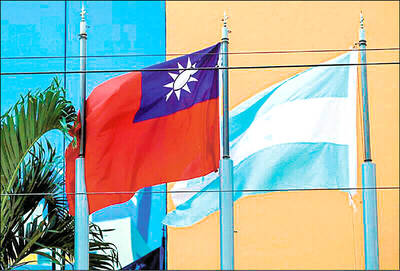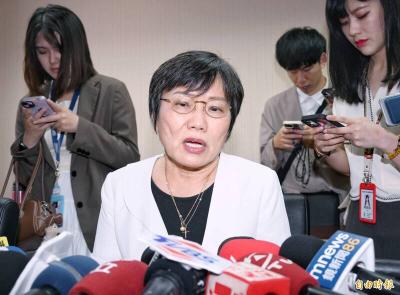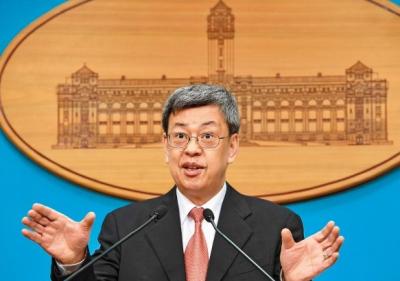A symbol and monument of the colonial history of Taiwan, Fort San Domingo, was handed over by the central government to Taipei County Government yesterday.
The handover ceremony yesterday morning was celebrated with loud traditional big-drum beating, performed by elementary school pupils, and Taiwanese folk songs performed by local singers.
"It's like attending my daughter's wedding ceremony," said Yu Chen-hsien (余政憲), head of the Ministry of Interior.
The fort is a famous historic site and has been overlooking the northwestern Tamsui River estuary for over three and a half centuries.
According to the Cultural Assets Preservation Act (文化資產保護法), the local governments are the administrators of important national relics.
"However, Fort San Domingo is an exception, because the central government wanted to make it known to the world that this fort is ours, and no longer occupied by any extraneous regime," said Wu Mi-cha (吳密察), vice-chairman of the Council for Cultural Affairs(文建會).
"Therefore, the Ministry of the Interior had been the administrator until today," Wu said.
The maintenance and overall management of this historic site will now no longer be the central government's responsibility.
The fort, having been occupied and abandoned several times by different foreign regimes, has been seen as an encapsulation of Taiwan's history.
Built by the Spanish in 1629, Fort San Domingo soon became the Dutch colonizers' bridgehead, and the history of Dutch occupation gave this fort its better-known name "Hung Mao Cheng," or "red-haired devil's fort."
"Standing before Fort San Domingo, you will realize how small we are," said Taipei County Magistrate Su Tseng-chang (蘇貞昌).
"In the past 350 years, the handover of this fort has always gone hand-in-hand with fights and mass killings," he said.
In the late 17th century, Koxinga (鄭成功), son of a Chinese pirate, defeated the Dutch and took control of the fort before the Chinese renegade regime he founded was destroyed by the Ching Dynasty.
"Since then the British came, then the Japanese, and the British presided over it again after World War II," said Lee Chian-lang (李乾朗), an associate professor of folk arts at National Taipei University.
"When I was a boy, this fort was still used by the British government as its Consulate," he said.
The KMT government took over Fort San Domingo in 1980 after a series of negotiations with the British.
"Trapped as we are in history, we Taiwanese are miserable, but we also feel proud of ourselves," Magistrate Su said.
Now Fort San Domingo is not the headquarters of any colonial regime any more and has become one of the most famous historic sites in Taiwan.
The new administrator, the Cultural Affairs Bureau of Taipei County, has planned to make it the hub of the planned Tamsui Park of Historic Sites.
The maintainance of Fort San Domingo may be a financial burden for Taipei County.
Its upkeep amounts to NT$23 million a year, plus an amount of NT$37 million for re-construction fees, according to Lin Pe-yu (林泊佑), director of the bureau.
"But we are confident to maintain and operate this historic site very well," Lin said.

Taiwan would welcome the return of Honduras as a diplomatic ally if its next president decides to make such a move, Minister of Foreign Affairs Lin Chia-lung (林佳龍) said yesterday. “Of course, we would welcome Honduras if they want to restore diplomatic ties with Taiwan after their elections,” Lin said at a meeting of the legislature’s Foreign Affairs and National Defense Committee, when asked to comment on statements made by two of the three Honduran presidential candidates during the presidential campaign in the Central American country. Taiwan is paying close attention to the region as a whole in the wake of a

Chinese Nationalist Party (KMT) Chairman Eric Chu (朱立倫), spokeswoman Yang Chih-yu (楊智伃) and Legislator Hsieh Lung-chieh (謝龍介) would be summoned by police for questioning for leading an illegal assembly on Thursday evening last week, Minister of the Interior Liu Shyh-fang (劉世芳) said today. The three KMT officials led an assembly outside the Taipei City Prosecutors’ Office, a restricted area where public assembly is not allowed, protesting the questioning of several KMT staff and searches of KMT headquarters and offices in a recall petition forgery case. Chu, Yang and Hsieh are all suspected of contravening the Assembly and Parade Act (集會遊行法) by holding

PRAISE: Japanese visitor Takashi Kubota said the Taiwanese temple architecture images showcased in the AI Art Gallery were the most impressive displays he saw Taiwan does not have an official pavilion at the World Expo in Osaka, Japan, because of its diplomatic predicament, but the government-backed Tech World pavilion is drawing interest with its unique recreations of works by Taiwanese artists. The pavilion features an artificial intelligence (AI)-based art gallery showcasing works of famous Taiwanese artists from the Japanese colonial period using innovative technologies. Among its main simulated displays are Eastern gouache paintings by Chen Chin (陳進), Lin Yu-shan (林玉山) and Kuo Hsueh-hu (郭雪湖), who were the three young Taiwanese painters selected for the East Asian Painting exhibition in 1927. Gouache is a water-based

President William Lai (賴清德) has appointed former vice president Chen Chien-jen (陳建仁) to attend the late Pope Francis’ funeral at the Vatican City on Saturday on his behalf, the Ministry of Foreign Affairs said today. The Holy See announced Francis’ funeral would take place on Saturday at 10am in St Peter’s Square. The ministry expressed condolences over Francis’ passing and said that Chen would represent Taiwan at the funeral and offer condolences in person. Taiwan and the Vatican have a long-standing and close diplomatic relationship, the ministry said. Both sides agreed to have Chen represent Taiwan at the funeral, given his Catholic identity and